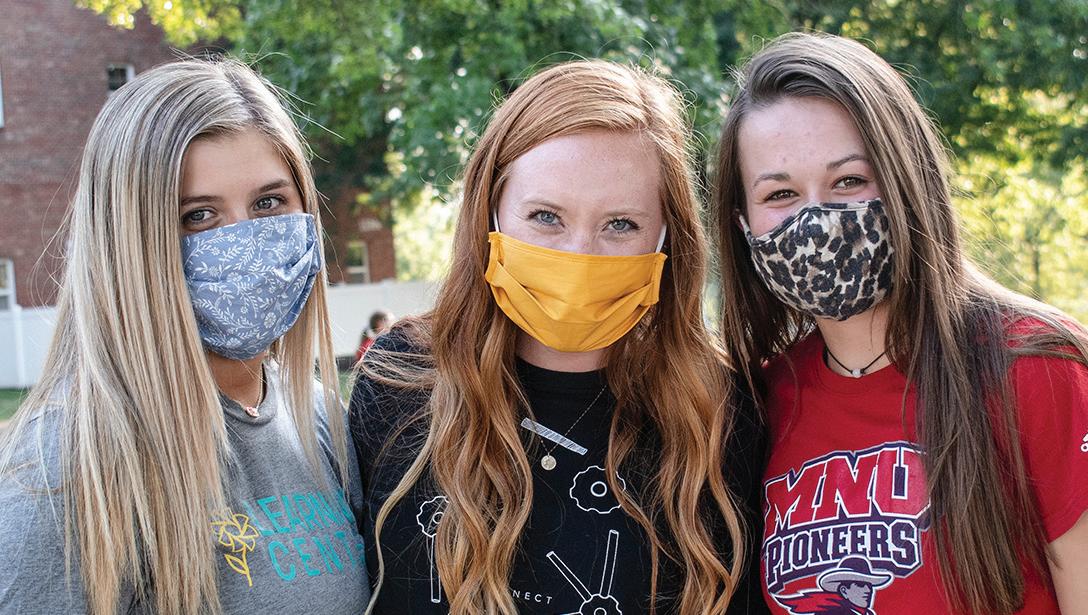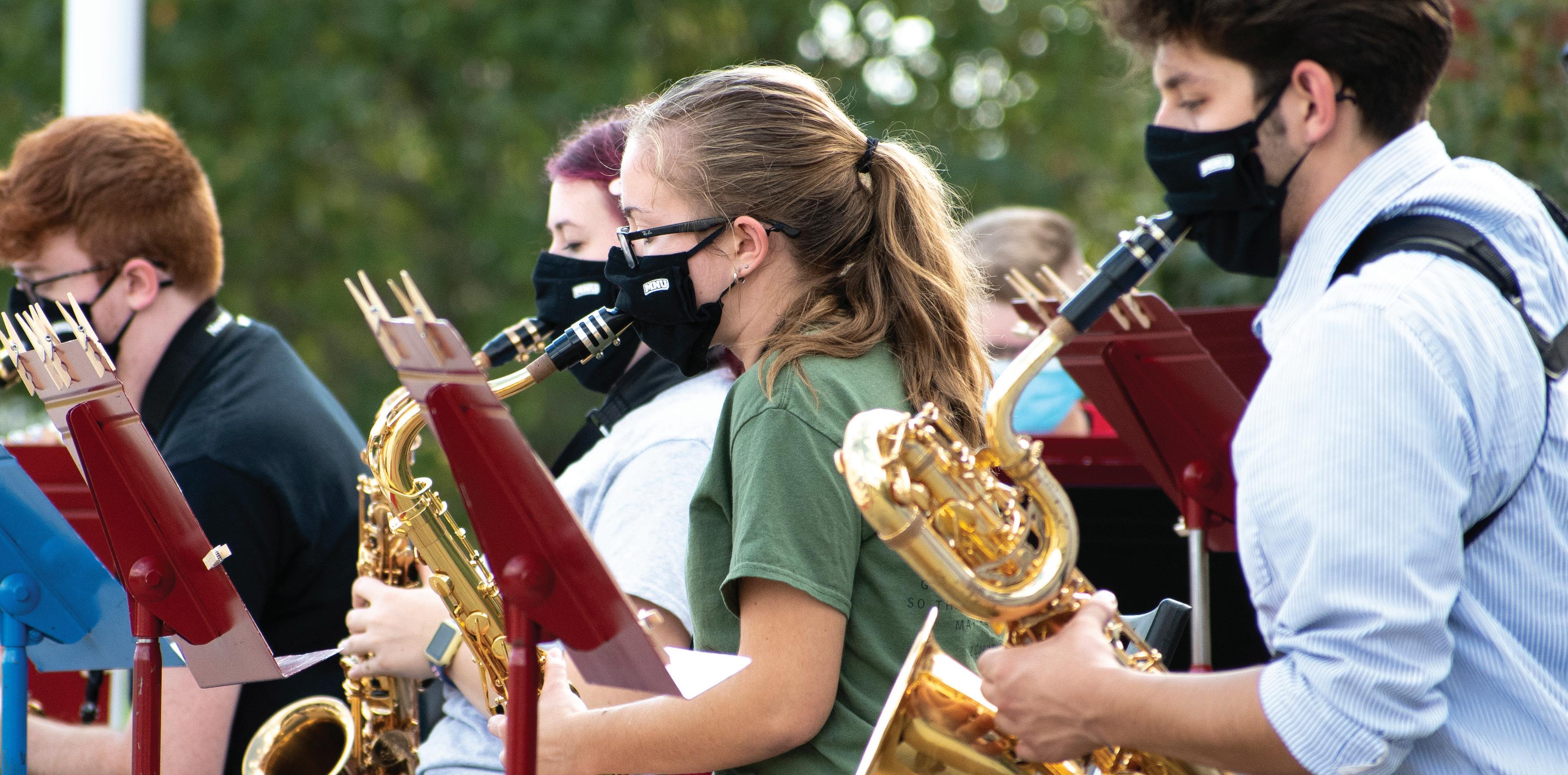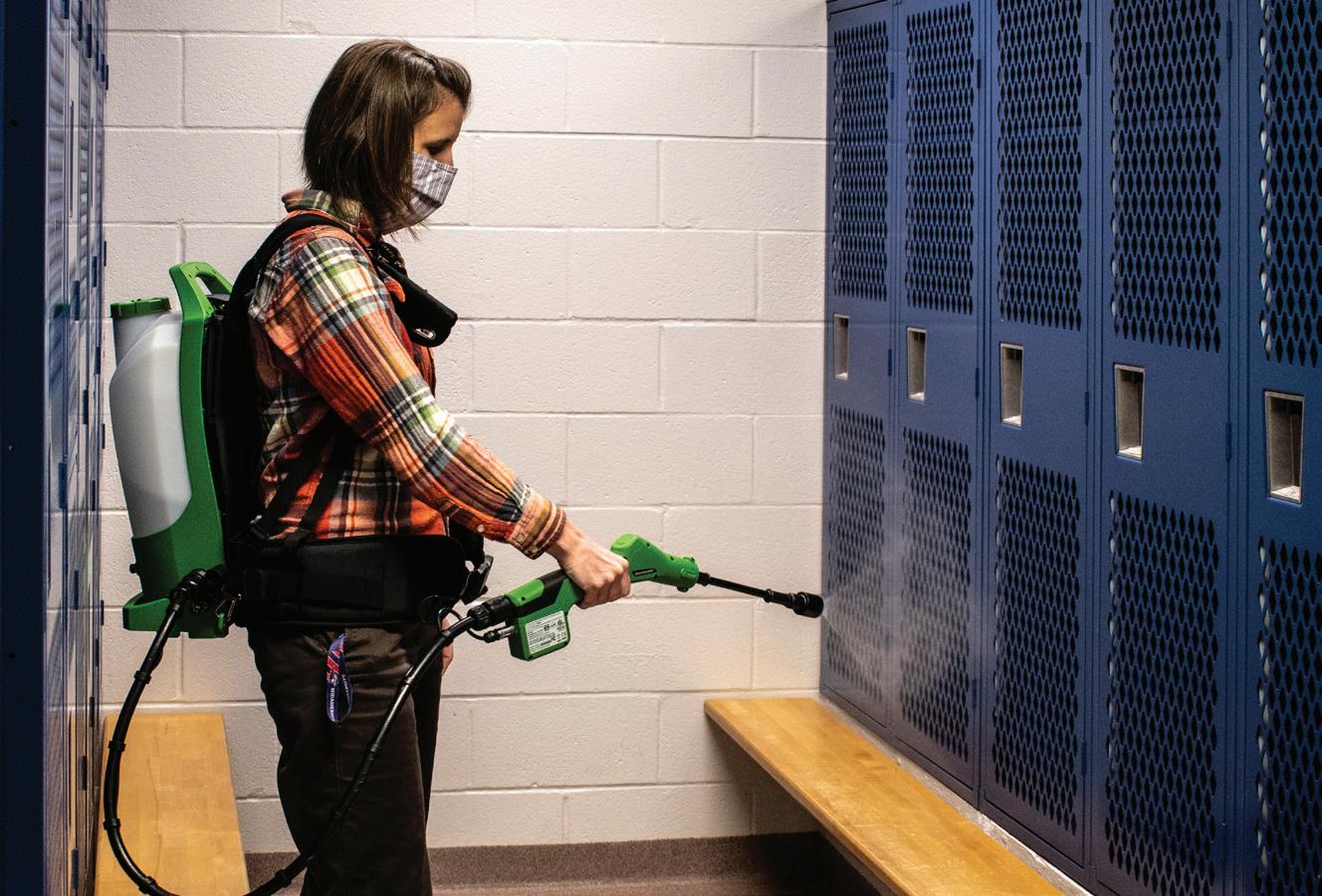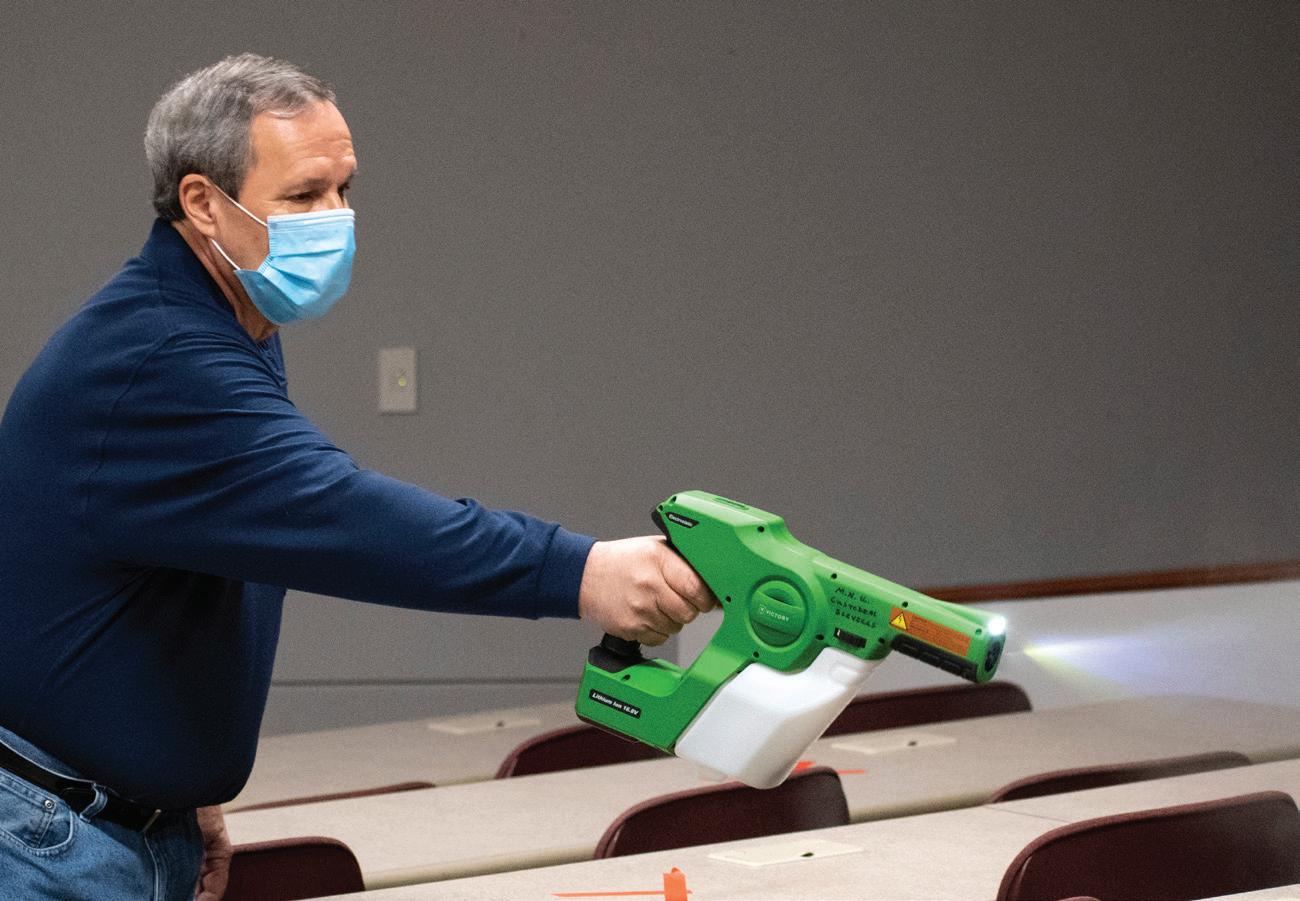
11 minute read
Resilience at MNU
In this together! Students gather at the Harvest Prayer Sculpture with MNU President Dr. David Spittal.
Almost before we knew it, COVID turned our lives upside down. It was a jolting shift that most expected would last only a few weeks. But months later, MNU is operating in an entirely new way to make on-campus, in-person education possible.
Why was it vital to reopen the campus? Students wanted to be back in person. Not only at MNU but across the country. An article from American Enterprise Institute by Kelly and Columbus (July 7, 2020) stated, “most students still strongly prefer face-to-face instruction.” In fact, a Niche. com survey of 16,000 students this summer confirmed that nearly 80% prefer taking classes in person.
But keeping living and learning on campus relatively safe during the pandemic is a daunting task involving every department and office.
ACCOMMODATIONS DURING COVID
MNU’s Emergency Response Team, a group of campus leaders, many trained in Multi-Hazard Incident for Higher Education, went into high gear when COVID hit our country. The team meets weekly to oversee protocol and planning for the university’s COVID-19 response.
THE PIVOT
Extending the 2020 spring break provided time for faculty to adapt their courses to online delivery. Most students went home to complete the semester, with fewer than 25 students remaining on campus due to jobs and other issues. Employees whose responsibilities allowed, transitioned to work from home until June 29 when MNU workers began returning to campus. Faculty reimagined their courses in case the fall 2020 semester needed to be online. Various scenarios were considered throughout the planning process since, like the whole country, MNU leaders could not predict what conditions would be like in August. Thankfully, lower positive COVID numbers in the area allowed the university to start classes in person.
PROTOCOL
CampusClear is an application MNU requires for anyone, including visitors, who come on campus for more than 10 minutes. The app logs one’s symptoms of COVID-19, if any, and provides guidance or a “Good To Go” message if cleared to be on campus.
Face coverings and social distancing are required everywhere on campus. Frequent disinfecting is done at regular intervals during the day. Electrostatic cleaning devices are in use to disinfect high touchpoint/high traffic areas. Hand sanitizer and cleansing wipes are throughout buildings. Water fountains are for bottle filling only. Livestreams and online meetings are used when possible. Even Chapel and athletic events have moved to livestream to mitigate the gathering of large groups.
ACADEMICS: TECHNOLOGY TO THE RESCUE
Nearly every professor is teaching a “hybrid” course in which some students are remote while some are in class. Students in quarantine or who have accommodations online can still interact with their in-person classmates in these courses through video conferencing called Zoom. Dr. LeAnn (Kehr ’83) Yantis, associate professor of business and program director for the Online Bachelor of Business Administration, teaches both professional studies and traditional courses. “It has been interesting,” Yantis says. “I have the online students Zoom in, and I record it so they can review it later. I send them documents and worksheets in advance. I can Zoom from my podium computer or a laptop so I can share my screen in the classroom and online.” Yantis says she and the other professors work to include the online students with those in class. “We have swivel mics worn as a lanyard and when on, an iPad will swivel and follow the wearer as they move around the room. This way online students see what’s happening while we discuss.” While each department has challenges in delivering instruction safely, some have specialized needs.
ARTS & HUMANITIES
The Department of Arts and Humanities applied the results of the International Coalition Performing Arts Aerosol Study to set protocol for performing arts students. The study focused on the distribution of respiratory aerosol generated while playing wind instruments, singing, acting, speaking, dancing and in simulated aerobic activity. It studied respiratory aerosol, including volume, direction, density and mitigation strategies related to performing arts. In addition to social distancing, which causes many classes to be split into smaller groups, many other mitigating procedures are in place. Three styles of custom masks accommodate singers, wind instrument players and actors. Performing arts lessons, rehearsals and classes may only utilize a room for 20 minutes due to the buildup of aerosols. Then that room must be vacated for 30 minutes to clear the aerosols. To facilitate enough rehearsal space, outdoor gazebo-style tents with open sides and high-pitched ceilings were installed in the Bell


Students adapt to wearing masks on campus to follow state and county guidelines.
Center parking lot. Departmental events have also changed to protect students and patrons. Plays and concerts are held outside with limited audience size.
NURSING
Imagine having a nurse who graduated without ever getting real-world clinical experience. MNU faculty could not let that happen and though clinical sites started closing to students last spring, faculty created virtual simulations and critical thinking activities to prepare their students.
Simulations include those already on the market and MNU’s own created by faculty in the Simulation (Sim) Lab. Students watched the simulations online and debriefed
Resilience at MNU (Continued)
with one another and faculty virtually. Nationally, medical professionals say new nurses need more critical thinking, so faculty took the opportunity to devise a wide variety of critical-thinking activities to replace clinical hours.
As restrictions lifted in the summer, faculty were able to take small groups of students into the Sim Lab, rotating the class through the process.
“Intensive sessions were held in the Sim Lab prepping our accelerated BSN students with nursing skills they had not been able to do in person,” says Crysti Danahy, DNP, RN, chair, pre-licensure nursing, director of operations and associate professor of nursing. “They were able to practice and complete check-offs before their clinical placement. Some had practiced at home with family, but there’s only so much that you can do. We would not send a student to a practice partner who had never touched some of these objects.”
Danahy says that MNU’s 28 practice partners allow students to do clinical experiences to some degree now.
NATURAL, HEALTH & MATHEMATICAL SCIENCES
Large classes are split and held in separate classrooms to accommodate social distancing. Professors teach in one room while livestreaming it into one or two other rooms. In the case of labs, three lab sessions become six sessions for professors to teach. Additional teaching assistants (upperclassmen) were added to assist with questions and grading. Students’ lab partners are kept the same all semester to minimize potential exposure. When possible, labs are completed without partnering. Lab sessions are now wet lab or dry lab. Wet lab performs experiments with equipment and supplies, while dry lab work is done with computers and worksheets.
“There is a lot of learning that can occur outside the lab that is good preparation or practice for students when they are in wet lab,” says Dr. Abby Hodges, chair, natural, health & mathematical sciences, professor of chemistry.
Another aspect of COVID is the undeniable increase in workload, but Hodges says the biggest challenge is less interaction with students and colleagues outside the classroom. However, there are positives.
“Class attendance is up,” Hodges says. “The students want to be in class.”
Anecdotal evidence from faculty appears to support her statement. Professors consistently report that students say they are thankful to be in class and on campus.
TEACHER EDUCATION
Amid COVID changes, the Teacher Education Department still needed to place preservice teachers (teacher education students) in clinical experiences. During October, these students typically spend 25 hours a week in local elementary, middle and high schools, gaining vital experience. This summer, Dr. Ruth (Gleason ’81) Waggoner, professor of education and clinical director, contacted local school districts to see if they would take placements this fall.
“They understand the importance of preservice teachers having these experiences,” Waggoner says. “Some districts were not allowing anyone other than teachers and students in their buildings, but they all agreed to take our practicum students. All of our students will have different experiences depending on the district where they are placed, from in-person to hybrid to remote.”
MNU faculty provided extra training before practicum placement. Waggoner made sure each preservice teacher had instruction on the protocol in their school district.
“We told them to follow the guidelines to a tee. We said if the district says social distance by six feet, we want you
Accommodations during COVID-19
Electrostatic cleaning devices disinfect regularly Employees return to campus June 29 Face coverings Enhanced sanitation of common areas MNU’s Emergency Response Team activated Employees work from home Few students and employees stay on campus CampusClear app reports symptoms The PIVOT Spring Break extended Faculty adapt classes to online School opens with new protocols Social Distancing Outdoor events expanded Semester wraps up and Commencement Ceremony postponed Planning for in-person or online classes for Fall 2020 Livestreaming Chapel and athletic events


Students wear masks fitted for performances with instruments, choir and theater.

to do seven feet,” Waggoner says. “If they say to wash your hands five times a day, do it six times a day. You represent MidAmerica, and we don’t want any extra burden on the school district because of your placement.”
School districts are happy to have extra help from MNU students. With additional protocol in place, teachers have less time to do group work with their learners.
“Practicum students can help fill the gap, and that is a blessing,” Waggoner added. “I have been so proud of our students. They have rolled with it, producing high-quality lessons wherever they are. I have not received one complaint about going into this situation, remote or not.”
ATHLETICS
The athletic department may have had more scrutiny from the public than any other area at MNU as they prepared for athletes’ return. The National Association of Intercollegiate Athletics (NAIA) provided vital guidance and regulation, allowing for competition.
About 400 in-season athletes were COVID-tested shortly after arrival. Daily screening with temperature checks,
(Continued on page 8)

Electrostatic cleaning devices are in use to disinfect high touchpoint/high traffic areas.

Resilience at MNU (Continued)
symptom checks and screening on game day within six hours before competition is required. Coaches are vital to athletes’ compliance as they uphold protocol and provide motivation to students.
Training rooms and locker rooms are only accessible at pre-appointed times. Social distancing is required during workouts, so the weight room moved to Land Gym to accommodate the space needed.
Everyone wondered how practice and competition would be accomplished in masks when physical exertion requires greater oxygen intake. Since teams are monitored closely and spend time together daily, masks are not required in practice and competition. However, masks are used on the sidelines.
Head Soccer Coach, Kevin Wardlaw, says he reminds athletes that beyond the sacrifices they are making to compete, they need to be thankful.
“I tell our guys that they’re getting the opportunity to play,” aren’t able to play and it’s affecting their college experience and even their future, depending on their aspirations and dreams. We’re extremely lucky to be playing.”
Todd Garrett (’94), athletic director, says the department’s Core Covenants are seeing them through the pandemic.
“We are reminding our athletes and coaches that looking out for the best interest of one another as well as ourselves will make the difference in getting through these challenges,” Garrett says.
RESIDENTIAL LIFE
One of the first concerns in preparing for on-campus learning to resume was considering the residence halls. MNU’s residential living includes traditional hall-style dorms with two large shared bathrooms per floor, suite-style living and townhouses. Each has its own set of challenges to keep clean, facilitate shared living spaces safely and allow for socializing among residents.
Student Development and Residential Life spent the summer making plans and developing protocol. Facilities Services had each dorm certified by an industrial cleaning specialist and put additional cleaning crews in place throughout campus. Areas were prepared for quarantine or isolation of students as needed.
And the most daunting task—helping students 1) understand the required protocol; 2) maintain social distancing in common residential areas; and 3) persist Wardlaw says. “There are so many places where guys
with these requirements.
WHAT HAPPENS IN QUARANTINE OR ISOLATION?
Though most students choose to go home, students who stay on campus to quarantine or isolate are housed in separate areas. Extra cleaning occurs in those spaces, meals are brought to them by residential staff. Hybrid learning, video conferencing and other methods ensure they can continue coursework. But make no mistake, it is a considerable challenge for young, vital students to live this way. Seeing friends meet this challenge has helped other students understand the importance of taking preventative measures seriously.



